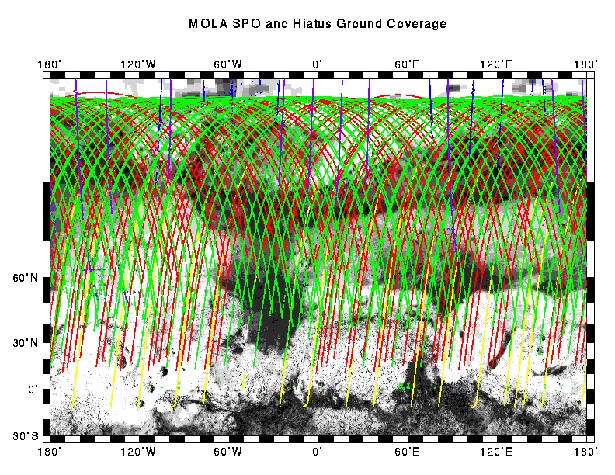 |
National Aeronautics and Space Administration Goddard Space Flight Center |
SEARCH NASA |

 MOLA MOLA |
During the Capture Orbit, Aerobraking Hiatus, and Science Phasing Orbit-1 and -2 (SPO-1 and SPO-2) subphases of the MGS mission from September 1997-August 1998, the MOLA instrument collected about 2.6 million high quality measurements of surface topography and cloud heights. In addition the instrument obtained measurements of returned laser pulsewidth and 1064 nm reflectivity.
Shown in yellow are the 18 capture orbit and aerobraking hiatus passes obtained in September-Noevember, 1997. Shown in red are the 61 passes obtained in SPO-1 in March-April, 1998. Shown in green are the 127 passes obtained during SPO-2 in June-July, 1998. Blue and purple groundtracks are weeks one and two of polar gap observations in June-July, 1998 (Credit: MOLA Science Team)
MOLA's first observations of Mars' northern hemisphere were collected during the capture orbit phase of the MGS mission shortly after orbit insertion on September 15, 1997. A further 17 passes were collected between October 14 and November 6, 1997 during a hiatus in the aerobraking phase necessitated by a study of the integrity of a solar panel that was slightly damaged after launch.
During the SPO-1 and -2, MOLA collected observations of Mars' northern hemisphere, with emphasis on detailed mapping of the north polar ice cap. General Circulation Model simulations by Robert Haberle at NASA Ames Research Center indicated that the period late June to early July 1998 was the expected to be the period of maximum ice loading for the northern cap for the current Martian year. This period represented an especially important time for MOLA observations. During July, 1998, MOLA observed in an off-nadir position while the MGS spacecraft was "tilted" on alternating orbits. This spacecraft maneuvering was undertaken so that MOLA could fill in the 2° coverage gap at the north pole that occurred because the spacecraft orbital inclination is not exactly 90°.
Return to the MOLA Science homepage

